How to find out when your Hasselblad was made
by Q.G. de Bakker
All Hasselblad cameras and film magazines, as well as some other Hasselblad items, bear a two or three letter code in front of, or incorporated into, the serial number. Two of these letters are used to encrypt the year of manufacture.
The key to translate these letters to digits is the word VHPICTURES, in which "V" stands for 1, "H" = 2, etc.
The digits indicate the decennium and year in which the item was produced.
For instance, a camera carrying the 'date code' "ER" was produced in 98, or 1998 ("E" = 9, "R" = 8).
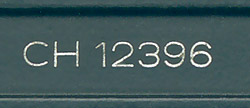 | Hasselblad 1600 F serial number with two letter year code "CH", which translates to (19)52. |
This system was adopted just before the middle of the 20th century, and the assumed prefix representing the century then was "19". The new millenium of course changed the prefix from "19" to "20".
This method of coding does not provide a way to tell what century prefix to add.
We just have to remember that it was first used in the late 1940's, and that years later than "49" upto and including "99" should be prefixed by "19". All years earlier than "50" will need the prefix "20".
Victor Hasselblad learned about this method of coding at Eastman Kodak's. The "magic word" used by Kodak was "CAMEROSITY", and the early 1600 F and 1000 F Kodak lenses can be dated the same way, using this Kodak keyword.
Kodak code "ET", indicating the year (19)49, on a
Kodak f/2.8 80 mm Ektar lens.
The encircled "L" sign stands for "Lumenized": Kodak's way of saying the lens has a (single layer) antireflection coating. | 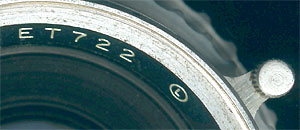 |
For a brief period, Hasselblad appended a third letter to the two letter date code. This third letter was used to indicate the product type.
A product type code reappeared in 1990, now in the form of a two digit code preceding the two letter date code.
When there are three letters, the year of manufacture is always indicated by the first two.
- In 1977 a "C" was appended to the code on 500 C/M cameras.
- Upto 1978 an "E" was appended to the code on EL and EL/M cameras.
- Upto 1979 a "W" was appended to the code on SWC and SWC/M cameras.
- In 1977 an "F" was appended to the code on 2000 FC cameras.
From 1990 onward, a numerical prefix was added to the code, designating the type of product.
This prefix provides no useful information to someone holding the item, and is for use in records only.
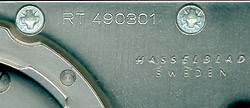 | Detail of mating surface of Hasselblad Winder F, showing serial number with two letter year code "RT", code for (19)86. |
How to date Hasselblad products not showing a serial number?
Items that do not have a serial number plus date code obviously can not be dated using the system described above.
Sometimes dates, coded or even uncoded, appear inside products, scribbled in pencil on the inside of housings, etc.
But taking, for instance, a prism finder apart just to look for an indication when the item was produced is perhaps not a very good idea.
Some items however can be dated (roughly) using other information, such as details of design, or mechanical differences, combined with information about when these items were available, when details of the items were changed, etc.
Such information can be found elsewhere on Hasselblad Historical, or in Richard Nordin's books "Hasselblad Compendium" or "Hasselblad System Compendium".
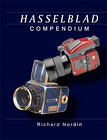 |
Hasselblad Compendium
Richard Nordin
Cloak Hill Communication, 2011
ISBN 978-0-9869188-0-3
|
Hasselblad System Compendium
Richard Nordin
Hove Books, 1998
ISBN 1-897802-10-2 | 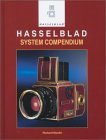 |
How to date Zeiss lenses?
Zeiss serial numbers do not contain coded information about when a lens was made. Serial numbers therefor can only be used to date lenses if we have some way to link serial numbers to years. Tables doing just that are compiled by collecting serial numbers of specific lenses together with information about when these lenses were first bought.
Such tables, providing the best estimates available, can be found in Richard Nordin's "Hasselblad System Compendium".
You can, of course, also type in the serial number of your lens into the tiny utility on the top left hand side of this page.
Zeiss however also stamped their lenses with a code revealing the date of manufacture. This code, most often in red ink, was stamped somewhere on the rear end of the lens mount, often on the wall of the rear lens baffle. To reveal the code, it may be necessary to set the lens to its close focus limit (doing so will move the rear lens element towards the front of the lens, out of the way). The stamp may be smudged, or incomplete, making it difficult to decipher.
It is present in all but the very earliest C lenses.
Early lenses sometimes are stamped more than once. The date of manufacture will most likely be represented by the earliest date found, while later dates may represent the times the lens had returned to the factory for a (major) repair.
- Before 1980 the code was a three or four digit number.
The last two digits always represent the month of manufacture. The key is the month's number ("1" for January, "2" for February, etc.).
The first, or first two represent the year of manufacture, which can be found by adding "1957" to the code.
- The code was changed in 1980 to a two digit + one letter code.
The two digits are a reversed representation of the year of manufacture. "28", for instance, is (19)82, etc.
The letter is a code for the month of manufacture, "A" standing for January, "B" for February, etc.
In later lenses a trailing "A" or "B" was added. The significance of which is still unknown.
Items shown:
- Detail of rear end of Hasselblad 1600 F camera body, showing date code and serial number.
- Detail of Kodak Ektar f/2.8 80 mm lens identification ring, showing Kodak date code.
- Hasselblad Winder F mating surface, showing date code and serial number. |
Copyright 2005, 2006, 2012 - Q.G. de Bakker. All rights reserved.
All material on this site is protected by law. Unauthorized use is prohibited.
- Hasselblad Historical -